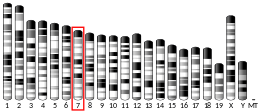PRRT2
Proline-rich transmembrane protein 2 is a protein that in humans is encoded by the PRRT2 gene.[5]
Structure and tissue distribution
This gene encodes a transmembrane protein containing a proline-rich domain in its N-terminal half. Studies in mice suggest that it is predominantly expressed in brain and spinal cord in embryonic and postnatal stages.[5]
Clinical significance
Mutations in this gene are associated with a number of movement disorders, most commonly paroxysmal kinesigenic dyskinesia where approximately 1/3 of cases will harbor mutations in PRRT2.[6][7] It has also been associated with episodic ataxias, and in particular in combination with various types of epilepsy.[8]
gollark: Actually, it was a GTech™ test to see how well you dealt with all my alts.
gollark: It would reflect actual use better.
gollark: Compress all the esolangs section down to 1 channel and add more off topic.
gollark: Also, I am against orbital nukes.
gollark: I don't have opinions either way on hubs or times.
See also
- Paroxysmal kinesogenic choreoathetosis
References
- GRCh38: Ensembl release 89: ENSG00000167371 - Ensembl, May 2017
- GRCm38: Ensembl release 89: ENSMUSG00000045114 - Ensembl, May 2017
- "Human PubMed Reference:". National Center for Biotechnology Information, U.S. National Library of Medicine.
- "Mouse PubMed Reference:". National Center for Biotechnology Information, U.S. National Library of Medicine.
- "Entrez Gene: Proline-rich transmembrane protein 2". Retrieved 2011-11-26.
- Chen WJ, Lin Y, Xiong ZQ, Wei W, Ni W, Tan GH, Guo SL, He J, Chen YF, Zhang QJ, Li HF, Lin Y, Murong SX, Xu J, Wang N, Wu ZY (November 2011). "Exome sequencing identifies truncating mutations in PRRT2 that cause paroxysmal kinesigenic dyskinesia". Nat Genet. 43 (12): 1252–5. doi:10.1038/ng.1008. PMID 22101681.
- Li J, Zhu X, Wang X, Sun W, Feng B, Du T, Sun B, Niu F, Wei H, Wu X, Dong L, Li L, Cai X, Wang Y, Liu Y (February 2012). "Targeted genomic sequencing identifies PRRT2 mutations as a cause of paroxysmal kinesigenic choreoathetosis". J. Med. Genet. 49 (2): 76–8. doi:10.1136/jmedgenet-2011-100635. PMC 3261727. PMID 22131361.
- Papandreou A, Danti FR, Spaull R, Leuzzi V, Mctague A, Kurian MA (February 2020). "The expanding spectrum of movement disorders in genetic epilepsies". Developmental Medicine and Child Neurology. 62 (2): 178–191. doi:10.1111/dmcn.14407. PMID 31784983.
External links
- GeneReviews/NIH/NCBI/UW entry on Familial Paroxysmal Kinesigenic Dyskinesia
- OMIM entries on Familial Paroxysmal Kinesigenic Dyskinesia
- NCBI gene
This article incorporates text from the United States National Library of Medicine, which is in the public domain.
This article is issued from Wikipedia. The text is licensed under Creative Commons - Attribution - Sharealike. Additional terms may apply for the media files.



